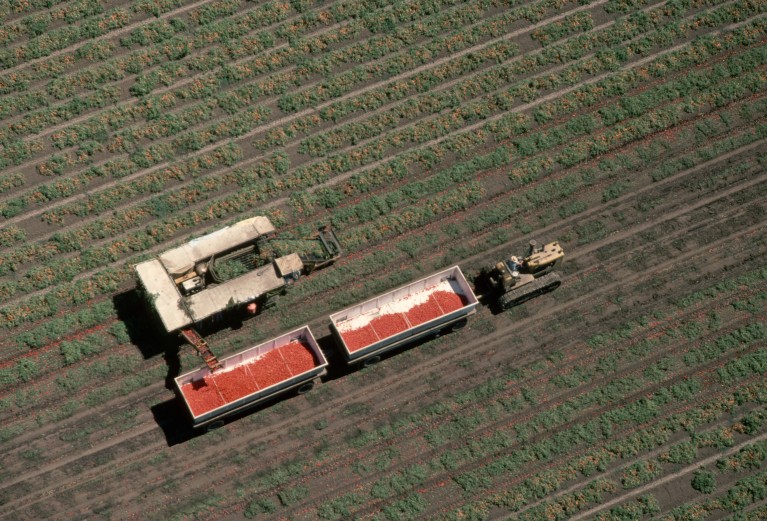Leggi in italiano
Credit: George D. Lepp/ The Image Bank Unreleased/ Getty Images.
Global warming will hinder the production and supply of processing tomatoes, and Italy will be the most affected among the main producing countries, a study in Nature Food finds1.
Unlike salad tomatoes, which are usually grown in greenhouses, processing tomatoes are grown in open fields, which makes them more vulnerable to environmental change. Globally, 40 million tonnes are used annually in canned products such as paste, sauce and ketchup, making this type of tomatoes the most important processed vegetable in the world. About 85% of the global production is concentrated in 11 major production areas known as ‘tomato baskets’, and three countries alone account for 65% of it: the United States, Italy and China.
Researchers from Denmark, the US and Italy combined three socioeconomic and five climate scenarios for the study. They simulated yield outputs under low, high and very high greenhouse emissions and linked each scenario to different rainfall and temperature conditions. Due to the involvement of Alex Ruane, an IPCC author from the NASA Goddard Institute for Space Studies, the study could rely on the most updated IPCC scenarios.
In all three countries, climate change is expected to cause, on average and across different scenarios, a 6% decrease of processing tomato production by 2050, compared to a 1980–2009 baseline period. Projected air temperature increases, and water resource constraints, will affect tomatoes, whose optimal growth is between 22°C and 28°C.
Simulated scenarios show minimal differences up to 2050, but there is substantial variability afterwards, up to 2100. Under the most pessimistic scenario, with air temperature increasing on average of about 2.6°C by 2070 and 5°C by 2100, global productivity might undergo a 60% fall, compared to baseline values.
Projections show also that future productivity differs from region to region. China will maintain a viable production until the end of the century, with a slight decrease after 2075 in the Xinjiang province, but warming will make Gansu and Inner Mongolia more suitable areas for growing processing tomatoes, giving them a competitive advantage. Similarly, cooler regions of Northern California will likely benefit from higher temperatures, but overall current production levels in California and Italy will be negatively impacted.
As for Italy, the second largest producer after the US, with 70 thousand cultivated hectares and 6 million tons of annual yield, each degree of temperature increase will correspond to a decrease of 0.4 tons per hectare in Foggia, and 0.3 tons per hectare in Emilia Romagna, the two areas considered by the study.
The overall expected yield decrease in Foggia is 18% by 2050, a slightly higher value compared to previous studies. “Agronomists, geneticists and plant physiologists should urgently join forces to tackle these issues” says Domenico Ronga from the University of Salerno, Fisciano, Italy, who led the collaboration.
Water consumption will be an issue too. Irrigation should increase by 25 to 150 mm of water per hectare in Italy, but water scarcity will make it challenging. “Growing tomatoes, particularly in Foggia, will be a hard task in 30 years from now,” says Davide Cammarano from the University if Aarhus, first author of the study. “Italy needs to prepare for a future with limited supply of tomatoes from local regions.”
“This work is innovative because most climate change impact studies on agricultural crops concern wheat, maize, rice, and potato” says Domenico Ventrella, from at CREA (Research Center Agriculture and Environment), who did not take part in the study. “Previous studies on processing tomato were done at regional or local level by adopting different climate scenarios, making it difficult to compare between different areas.”
